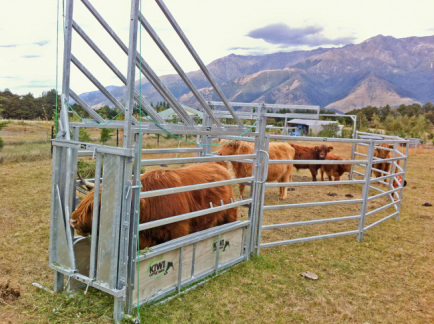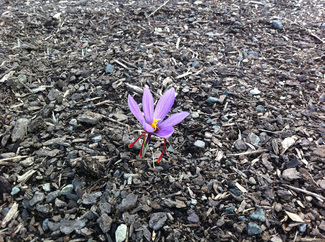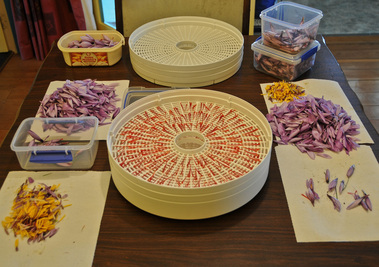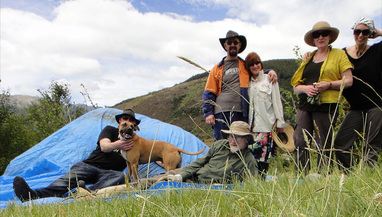chronicles
|
The great thing about organising your life around the farming calendar is that you're given plenty of time to cultivate a creeping sense of dread: Lambing's in September! OMG! Only five months to go! Or: It's April and nothing's growing in the garden except misshapen Brussels sprouts and spindly leeks! We'll be dead by October! So when we learned last year that all cattle have to be tested annually for tuberculosis, we had a good twelve months to work ourselves into a real lather at the prospect. As testing time drew nearer, a farmer friend warned us that the local TB testing guy didn't like "lifestylers" because they "don't have a clue". Forewarned is forearmed, as they say. We were determined to win the TB testing guy's respect. After all, we had yards! Our cattle would be docile and sweet. The job would be completed in under ten minutes. The tester would rub his grizzled head, cock an eyebrow and grunt his appreciation. We'd smile humbly and shake his hand. The day before the test, we had a practice session. It was a complete success -- took a mere hour and a half to get all six beasts into the yard and through the crush -- and they only charged through the temporary electric fencing once. No worries!*** When the TB testing guy arrived, he announced, "I bloody hate Highland cattle." Things kind of went downhill from there. Our animals, wary of the stranger, were anything but docile. They point-blank refused to enter the yards. Farmer Wan and I chased them around the paddock, flailing our arms helplessly. When we did finally get them yarded, Hamish the bull was stroppy and Bonnie, our huge alpha-female, bullied the others away from the crush. Then our young heifer burst through the head bail and ran off. At least the rest were tested. "I'll be back in three days," said the TB testing guy. "Try to have the bull in the crush and the rest yarded by the time I arrive."  Hamish = good. The rest = steak soon if they don't watch it. We knew we'd be okay the second time because we had reinforcements in the shape of my brother, Ciaran. Forty-five minutes before the tester was due, the three of us went out into the paddock, brandishing our polypipe waddys. We meant business. Hamish was feeling cooperative. We got him into the crush with very little trouble. Yay! This was going to be a doddle! Three-quarters of an hour later, the TB testing guy watched from his car as we tried -- and failed -- for the fourth time to get the other cattle into the yard. He ambled up the track towards us, just as they burst through the temporary electric fencing yet again and charged off into the back paddock through a gate that had somehow been left open. Farmer Wan threw down his waddy and swore loudly. The TB testing guy rolled his eyes and something in me snapped. I was going to get those damned animals yarded, even if it took the rest of the afternoon. While Ciaran kept the tester distracted with casual conversation, I chased them up the hill to the track, waving my waddy and yelling at the top of my lungs. They started trotting in the right direction, more from exhaustion than my efforts, I think. Just as they were about to break out and charge back down the hill, Farmer Wan appeared and drove them from the other side. Ten minutes later, it was all over. Done. Dusted. Finis. I couldn't believe it. "If I were you, I'd knock the big cow on the head. That dippy heifer too," said the TB testing guy as we walked him back to his car. "You're lucky I don't charge by the hour." He half-smiled, though, and I thought I saw the teeniest glimmer of something in his eyes. Not respect, but some kind of acknowledgment. So now we have a whole year in which to dread the next round of TB testing. If we do nothing else in those 12 months, it's clear we'll have to get our cattle more used to being yarded. We'll have to round 'em up and keep them doggies rollin', regularly. And that, my friends, is why it's perfectly obvious that I need a stock whip ... desperately need a stock whip. My need is dire -- it's not just about the cool sound they make and the fact that I've always wanted one ever since I saw the Indiana Jones movies. I'm sure the TB testing guy would back me up 100% on this. Posted by Farmer Nik *** For the benefit of friends and family who know even less about farming than we do, that result was woeful.
2 Comments
 Oh, you pretty thing ... I'd been getting a little nervous about how this year's saffron harvest would go. Apart from topping up the raised beds in mid-December (thanks to Margaret of Clan Davidson for spending an entire afternoon pushing barrows full of compost uphill) and doing the occasional bit of weeding, we didn't pay them much attention. Then we had six weeks of hot weather and no rain. Farmer Wan hooked up a sprinkler, gave the parched corms a drink and we waited. Much to our surprise, our first flower popped up on 30 March, two days earlier than last year.  Wednesday: only another 300 or so to process Everything's different to last year, this time around. Although we're not harvesting 500 flowers a day, as the guy we're growing for said we might, there are definitely more of them. Yesterday, I picked 344. On Wednesday, we processed 745. And yeah, I count them. Last year, we had a lot more foliage appear before the flowers. This year, it's the other way around, which I suspect is how it's meant to be. The red stigmas (the actual saffron bits) seem longer this year. There's a higher proportion of doubles, rather than the more desirable triplets. I'm not sure why. I think the 2013 harvest may well be more drawn out. The corms were all planted on the same day last year and most of the plants came up at the same time. This year, we still have entire rows yet to break the surface. We've got the processing side of things down pat now. It's fiddly work but satisfying, in its way. The most challenging part of the whole process is the drying. Last year, we under-dried. This year, we might have gone a little too far the other way. It's a nerve-wracking prospect because perfect product means top dollar. We won't know for sure until it's sent away and analysed. In the meantime, we'll do our best to get it spot-on. And now, to prove there's a lot more to Farmer Wan than simply building chook houses, chopping firewood and constructing bunny-proof fences, feast your eyes on his gorgeous images of our exotic cash crop. Posted by Farmer Nik It was Thursday 13 December and stinking hot. Farmer Wan and I were making our first cut of hay in the orchard. Our orchard is approximately one quarter of an acre in size, which equates to 1,011.71 square metres or .101171 of a hectare. I’d just like to say that it feels a hell of a lot bigger than that when you’re cutting it with a scythe. In order to forestall my breaking down and sobbing bitterly when contemplating the enormity of our task, I made up a song – a little scything, hay-making song – and sang it very loudly and off-key (on purpose, of course, for comic effect). It’s sung to the tune of We Are The World, a composition that was considered very worthy for all of about ten minutes, way back last century: We are the world We are the farmers We are the people gonna grow your food So you’d better not harm us We are the world We are the growers So you’d better come to Muntanui And get to know us Farmer Wan came up with the last two lines, so we’re both to blame for the end result. As for the bit about growing everyone's food, well, I'll get back to you once I've managed to grow our own.  The hay crew (image courtesy of Cat Davidson) After two days of scything, a further two days of diligent turning with a pitch-fork, and one could-have-been-but-wasn’t case of heat stroke, the weather turned. The hay was beautiful but still not dry enough to bale. Fortunately, we had help in the form of Clan Davidson, dear friends who were visiting from Scotland and Oz. They helped us rake the hay and stash it under the Biggest Tarp in the World. A few days later it was ready. But we weren’t. Not by a long shot. The problem was, how to bale hay when you: a) don’t have a baling machine b) don’t have enough hay to interest a contractor c) are trying to come up with solutions that don’t involve large amounts of fossil fuel and cash. Solution Mark 1 was based around the idea of a wool press: After four hours of very hot, scratchy and tiring work, we had 30 micro-bales – probably enough to feed our cattle for a week. Although we’re not afraid of hard work, we concluded that this method was just too labour-intensive and therefore, unsustainable. We made the second hay cut at the end of January/early February. Solution Mark II to the baling problem was the Hay Sack, basically a great big bag stitched out of bird netting with a strong tie threaded through the top. It’s rodent-proof, it lets air circulate and it’s sort-of stackable. Fun factor and sculptural qualities notwithstanding, we know our Hay Sacks aren’t really a solution either. They're not practical for the amount of hay our cows will need over winter.
We still think it’s worth the effort to cut as much hay as we can ourselves because the orchard stuff is the best grass we've got – weed-free and full of yummy clover. And it doesn't cost anything except time. But we always knew we'd have to get in more and, given that we were teetering on the verge of drought for eight weeks, we were worried that no-one would have any to spare, and if they did, that it would cost a fortune. Enter the wonderful Gary and Kirsten from nearby Waireka Downs farm. They'd contacted one of our absentee neighbours about mowing his paddocks and asked us if we'd like some. So we now have 141 bales in our shed, it only cost us what it cost Gary to operate his equipment and we're set for winter ... we hope. And while the bovines are happily munching hay in the snow, we can plan how to increase our own hay cuts next year. Posted by Farmer Nik Huge thanks also to the Shaw family who transported Gary's hay to us and helped stack it. |
About Ewan and NikiFarmer WanScottish mechanical engineer with a deep and abiding passion for good food. Outstanding cook. Builder of lots of stuff. Cattle whisperer. Connoisseur of beer. A lover rather than a fighter. Farmer NikKiwi writer and broadcaster who hates cabbage, even though she knows it's good for her. Chook wrangler. Grower of food and flowers. Maker of fine preserves. Lover of dancing and wine. Definitely a fighter. Archives
November 2016
Categories
All
|


 RSS Feed
RSS Feed
